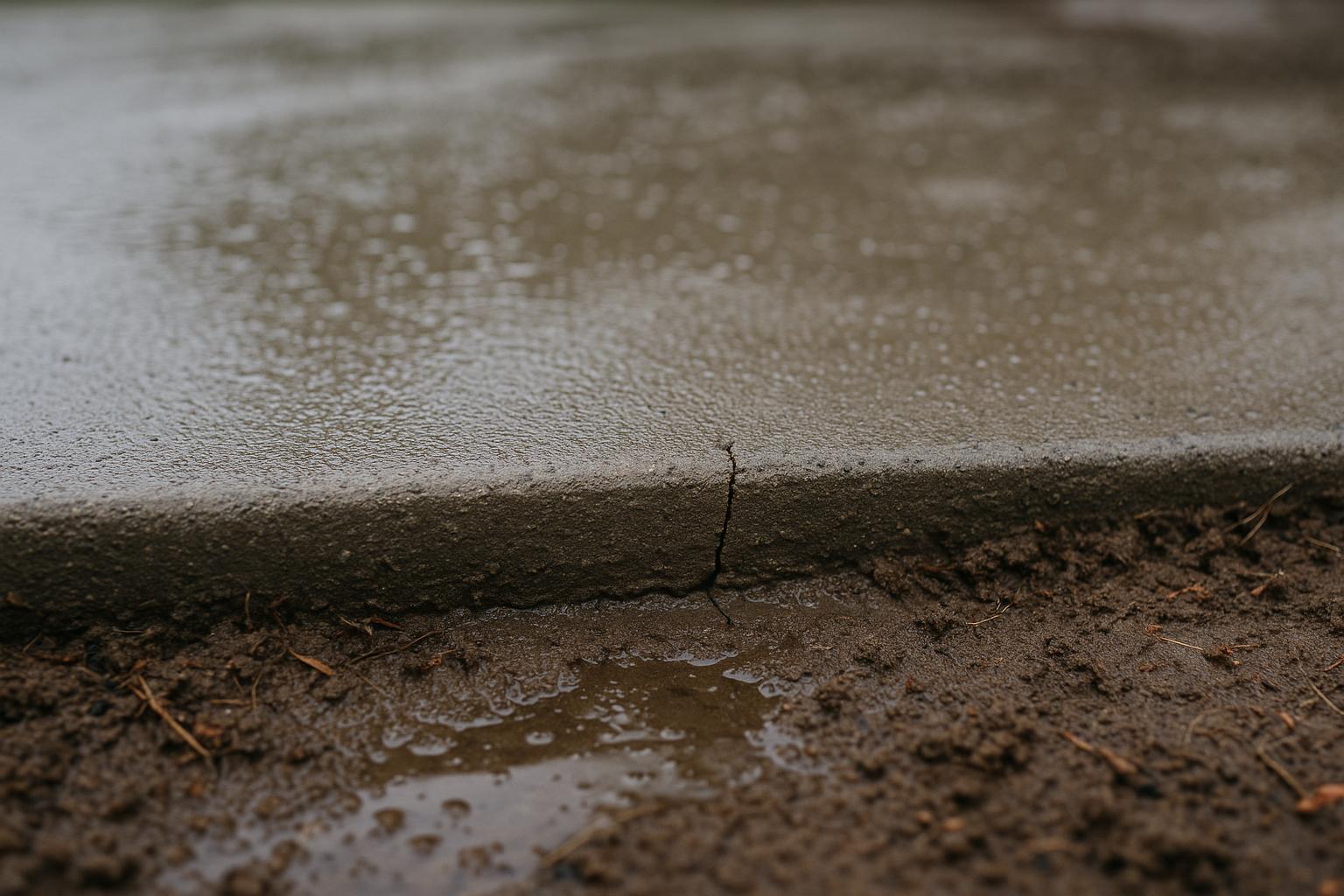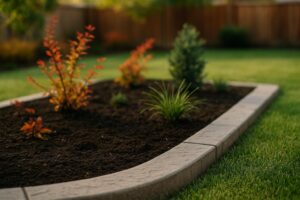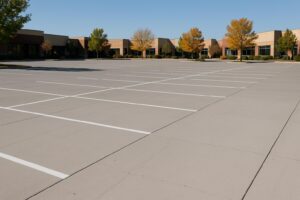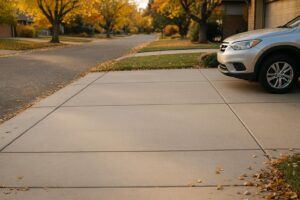Protect Your Property from Water Damage Below the Surface
For Denver homeowners, the late summer monsoon season brings welcome relief from the heat. However, these heavy rains can create significant problems beneath your feet. As water saturates the ground around your home, it builds immense force against your concrete slabs—a phenomenon known as hydrostatic pressure. This unseen power can lead to settled driveways, cracked patios, and uneven walkways, creating trip hazards and diminishing your property’s value. Understanding this pressure is the first step toward protecting your investment.
What Exactly is Hydrostatic Pressure?
Hydrostatic pressure is the force exerted by a fluid at rest. In the context of your property, the fluid is rainwater that has soaked into the soil. When the ground becomes oversaturated, the water seeks any path of least resistance, pushing upwards against concrete slabs or sideways against foundation walls.
Here in Denver, our notoriously expansive clay soil makes the problem worse. Clay soil absorbs a significant amount of water, swelling in volume during the rainy season. When it dries, it shrinks. This constant cycle of expansion and contraction creates voids and unstable soil conditions beneath your concrete, making it far more susceptible to shifting and settling under hydrostatic pressure. What starts as a puddle can quickly become a costly repair if left unaddressed.
Key Signs of Hydrostatic Pressure Damage on Your Concrete
Catching the problem early can save you from more extensive damage. Keep an eye out for these common warning signs around your property:
- Sinking or Uneven Slabs: One section of your driveway, patio, or sidewalk is noticeably lower than the adjacent one.
- New or Widening Cracks: While small hairline cracks can be normal, larger, growing cracks signal underlying stress. If you need concrete crack repair, it’s often a sign of a deeper issue.
- Water Seepage: You notice water pushing up through cracks in your garage floor or basement slab after a heavy rain.
- Hollow Sounds: Tapping on the concrete produces a hollow sound, indicating a void has formed underneath the slab.
- Trip Hazards: The edges of concrete slabs are no longer flush, creating dangerous uneven surfaces.
The Modern Solution: Polyurethane Foam Injection
In the past, the only options for sunken concrete were a messy, disruptive process called mudjacking or a complete replacement. Today, there’s a far more efficient and effective method: polyurethane foam injection. This advanced technique addresses the root cause of the problem—unstable soil—by lifting and leveling the concrete from beneath.
The process is straightforward and minimally invasive. Small, dime-sized holes are strategically drilled into the sunken slab. A high-density, two-part structural polymer is then injected into the voids below. As the components mix, the foam undergoes a chemical reaction, expanding to fill every gap and gently lifting the concrete back to its original position. The foam cures within minutes, becoming rigid, waterproof, and incredibly strong, providing a stable foundation that resists future erosion and water intrusion. This makes it an ideal solution for residential concrete lifting tasks on driveways, patios, and pool decks.
Did You Know?
Polyurethane foam used for concrete lifting is a closed-cell polymer. This means it’s hydrophobic—it repels water. Once cured, it creates a waterproof barrier under your slab, actively preventing future water erosion and damage from hydrostatic pressure. It’s an environmentally stable material that won’t break down or leach chemicals into the soil.
Polyurethane Lifting vs. Concrete Replacement: A Comparison
When faced with sunken concrete, many homeowners wonder if they should just tear it out and start over. While replacement is necessary in some cases of extreme damage, professional concrete lifting is often the superior choice.
| Feature | Polyurethane Concrete Lifting | Full Concrete Replacement |
|---|---|---|
| Time | Completed in hours; ready for use same day. | Takes multiple days; requires lengthy curing time. |
| Cost | Typically 50-70% less expensive. | Significantly more expensive due to labor and materials. |
| Disruption | Minimal; no heavy equipment on your lawn. | High; involves demolition, heavy machinery, and landscape damage. |
| Root Cause | Addresses poor soil conditions by filling voids. | Does not address the underlying soil issue. |
Protecting Your Denver Property Investment
Your home is likely your most significant asset, and maintaining its structural integrity and curb appeal is crucial. For Denver property owners, this includes being proactive about the challenges our unique climate and soil present. Sunken concrete is more than an eyesore; it’s a liability and a sign of potential foundational problems. By addressing these issues with a permanent solution, you are not just fixing a slab—you are preserving your home’s long-term value. This is especially true for commercial concrete repair, where safety and accessibility are paramount.
After lifting, it is vital to prevent water from penetrating the slabs again. Professional crack and joint sealing creates a flexible, watertight barrier, stopping the cycle of water damage before it can restart. For those looking to further enhance their property, services like decorative concrete borders and edging can beautifully frame your newly leveled surfaces. For more info on our service locations, see our service areas page.
Don’t Wait for a Puddle to Become a Problem
If you’ve noticed sinking or cracked concrete around your Denver home, take action. Let the experts at Elevate Concrete Lifting provide a free, no-obligation assessment to restore the safety and beauty of your property.
Frequently Asked Questions (FAQs)
How long does polyurethane concrete lifting last?
Polyurethane foam is a permanent solution. It is a highly durable, inert material that does not break down in the soil. It will support the slab indefinitely, provided the underlying soil issues are properly addressed and significant new water problems (like a broken pipe) do not occur.
Is the concrete lifting process disruptive to my property?
Not at all. Polyurethane foam injection is one of the least disruptive repair methods available. Our equipment is contained in a single truck, and we only need to drill a few small holes in the slab. Your landscaping and property remain untouched, and the area is ready for use almost immediately after we finish.
Can all sunken concrete be lifted?
Most sunken concrete slabs can be successfully lifted. However, if the concrete is severely cracked into many small pieces or has crumbled, replacement may be the only option. Our team at Elevate Concrete Lifting can provide a thorough assessment to determine the best solution for your specific situation.
Glossary of Terms
Hydrostatic Pressure
The pressure exerted by a fluid (typically water) at rest due to the force of gravity. In construction, it refers to the force of groundwater pushing against a home’s foundation or beneath a concrete slab.
Polyurethane Foam
A high-density structural polymer used in modern concrete lifting. It is injected as a liquid and expands to fill voids, lift slabs, and stabilize soil. It cures into a lightweight, strong, and waterproof solid.





